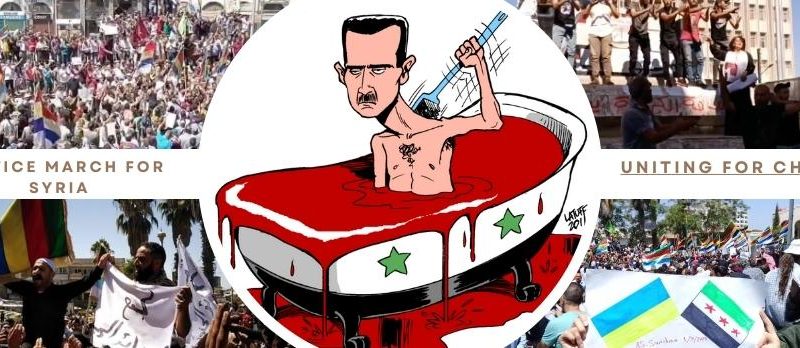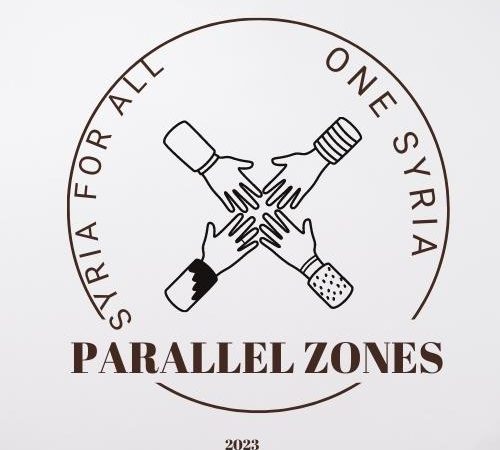QUNEITRA IS SAFE ZONE IN SYRIA

Wrote by: Issam Khoury
09/01/2016
Quneitra is located on the Israeli-Syrian border. Madina elBaath is the center of the province, and is under the authority of the Assad regime. The majority of the province however, is under the authority of the Syrian opposition.
The names of cities and towns in Quneitra province accordance to the Syrian government:
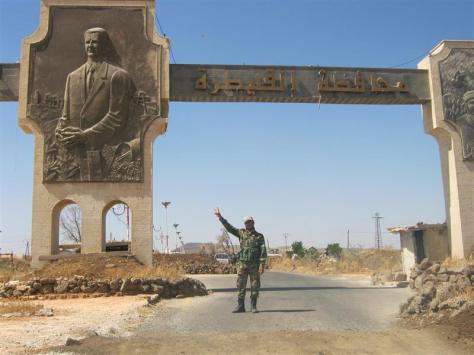
The Quneitra areas are as followed:
Alhimidih- Mansoura – ein Alhamra- um Alazm- Almsherfeh- Althalajiat- Alqtrani- beer seif- ein Hor- Aladnanah- ein Zewan- Aldloh- Alsnislh- Algsanah- ein Aahh- Kafr Nfach- alalika alshamalia- alalika alganubia-dabura- Naran Gharbah- Naran Alcherqah- der Sras- Owaynat alshimalia-Owaynat Aljnobih- Alkadirih- ein Alsemsm- der Alrahp- Alsnabr- Alldorh- Alfakhurh- Almin- Mazirah- Abu folh- Qahtanih- Asamadanah Gharbah- Asaleya and Mjama- Zmimirh- ahamdih, Agam- Khalidiya Alqbo- Ejraba- Sirah Kherfan- um Sdrh- galibina- Drijat- Khuejh- Dardarh- Aldelhmah- Alersanah- Dhabiah- Asindianh- ein Alqrh- shakif- Suehih- bab Alhoy- uyun Ahadjl- kurz Ataiwal- Ahadjv- Ngelh- kasrin- Ba’ath- Rohristinh- Zubaydah Alcherqah- Zubaydah Gharbah- resem Halabi.
Masada area includes the following villages :
Msaadh- Jbb Almis- Majdal Shams Jbata Alzit- Banyas- ein kuenih- ein fit-ein Aldezh- Zaourh- Alghgjr- shoka Alfoqa- shoka Altaha- Bakaatha- wasit- uyun alsamak- Alngelh- Alabasih- Alsmakh- ein Altenh- Alderbashih- Craze Allowaoa- alKula- Khirbet Albeida- mrar shaba- Moash- alhesen: Sirah zeab- Almncih- Zbidin- Nfelh- Rmta- Rabaa- alFren- Alguenabh (alzaaria ) – Ain altarik, almrgeir .
Khan Arnabeh area includes the following villages :
Khan arnabe- ein Alnoriah- nabee Alfoar- Alatm- Asamadanah Alcherqah- Alrvkiadeh- Agref- Jbata Alkhcb- Juba – hader – ein altineh – Alkuenif – alsumud – Sheita – Mshrh – um batna – alrikad alsrir – Karam Naam – alkabu – Tranjh – mumatane – Oyubh – nabe alsakher – Ein Al Basha – Mjdolah – almurabaat – Commune – Almnatahat -kamunia – Almenbtah, alBasha – Jfiet – resem altahune – resem alKharrar – Khalidiya – Mushayrifah – um alazaam – Ahals – Oovannih – alhuria – ein aldarb – resem alabed – almushakak – alMansour – alsabah – alKom – ein aisha – kom Mehaires – alsandania.
alkhashabia area includes the following villages :
Khashnih, Breka,um aldananir,Kodnh,Abu Qubays, ein Ziouani, Joazh, Alrmthanih, Mushayrifah, Alosubh, Qosaybeh, Soash, Alahjh, Abu Qatta, Manshiet Asuezh, Aldoaah, Aldoaah, Frakhh, Rafid Hieran,Tnorah, Sheba, Noanah Humera Batmah, Dhabah, Faraj, Fazarah, Mushatta, Elierbah, Kerks, Ayn al – Bustan Ghadir, Alloks, Albesala and Amra Aspth .
Madina fik area includes the following villages ::
Kafr, Ezzedine, Skovia, Hkom, Barak, Alyakosh, Saffuriyya and Khesfin .
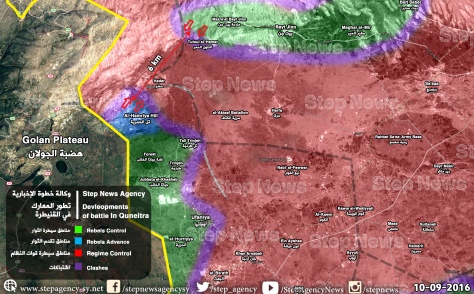
Areas under the authority of the regime :
The most important areas that are still under the Assad regime’s authority are Madina Albaath, Khan, Arnabe, Hader, Camp Faouar, Tel alshaar, Tel alkrum, Tel alahmar and Tel albazak. The 90 brigade is one of the main military headquarters and factions which were holed up by the regime.
There are no exact statistics about the population living in this region.This is due to the displacement of a large number of Assad loyalists into these areas.Surely, the area has at least doubled in it’s population size. Also, as a result of the instability between Israel and Syria,the Syrian regime has sought to transfer a large number of troops to the camps. It oversees the Quneitra area and its regime posts in many villages and towns became the largest rallying place of the regime in south Syria. This area was known as ‘the triangle of death” and was located in the Daraa district.In addition to the Brigade 90, the opposition estimates the number of residents within the regime areas is nearly 20% of the Quneitra district population.
Hezbollah and the regime areas: Hezbollah seeks to support the Syrian regime, which has backed the group in 2012-2013. Hezbollah sent a large number of fighters to join its military advisers, who previously trained the Syrian and Palestinian fighters on the guerilla warfare that Hezbollah perpetrates in south Lebanon under the supervision and training of head of the military wing of Hezbollah, Imad Mughniyeh. Mughniyeh was killed in Damascus and it is not yet known who assassinated him. He was accused of several coordinated terrorist operations, carried out in several areas around the world.
Currently there is a strong presence of Hezbollah and within the Brigade 90, in addition to the predominantly Druze area of Hader.
National Defense groups: Militias have been armed by the regime to defend the towns under their control. During the beginning they were fighting alongside the regime army against the opposition, but the militias suffered huge losses. This prompted residents to requests which confined their missions within their villages, which is what is currently happening.
Areas controlled by the opposition :
As noted earlier, the majority of the province is under oppositional authority. The National coalition attempted to form a council in the province of Quneitra and succeeded, naming several governors and mayors as members and also forming a small court. But the work of these agencies was unstable, due to the lack of providing financial and relief aid, as well as the lack of discipline of their military in the province.
There are no precise figures on the population, which live in opposition areas as a result of displacement from Daraa and Damascus. The number likely exceeds 300,000. Some opposition groups say the number has exceeded 400,000. The majority of refugees have chosen to set up camps near the Israeli-Syrian border with the belief that this region is under the protection of the United Nations force. The risk of missile attacks is also much less than their counterparts on the Syrian territory. The number of camps in the Quneitra district is currently six, and the inhabitants are suffering from the absence of basic services. Electricity, water and communications are unattainable. The lack of these services are not just within the camps but extend to all villages and towns in the area. The regime destroyed a section of the schools within the punitive policy in opposition areas, and the schools that were not destroyed were used by refugees as living facilities.
A large number of armed militias spread in the province. (Jabhat Ansar al-Islam, Jabhat Suar Syria, Aluyat Alfurkan)

Jabhat Ansar al-Islam
Jabhat Ansar al-Islam was founded in 2012 and led by Khaled Habbous. He is also known as ‘Abu majed alJoulani’, the political director of the office, or ‘Abu Maaz al-Agrha.’ Jabhat Ansar al-Islam fighters spread in Damascus and its countryside over south Syria, specifically Quneitra. Their goal is to form an Islamic regime with islamic laws which will control Syria. They have financial support provided by Islamist relief organizations. They also have the support of a number of educational institutes which encourage Islamic education that incites to jihad against the Syrian regime. Apparently,the military wing of the Muslim Brotherhood is the main source of support for this militia.
https://www.youtube.com/watch?v=6H_SniRyl8I
Jabhat Suar Syria
Founded in 2013 in Idlib, with support of the international coalition led by ‘gamal maaruf”, the militia achieved great victories while prompting to establish several branches in Aleppo and in south Syria.The militia eventually faced hardships when it collided with Jabhat al-Nusra.This was initiated in cooperation with Jund al-Aqsa to take the fight against Jabhat Suar Syria. They were accused of cooperation with the West and as a result Jabhat Suar Syria in north Syria was liquidated. Its military wing remained active in southern Syria, through coordinations with Almok, who were receiving aid from friends of Syria.
In 2013 the leadership of Jabhat Suar Syria faced setbacks when four of the most prominent commanders in the south had been hit. This led to the dispersion of the leadership, paving the way for the most prominent armed wing ‘Lyua seif alla al-maslul,’ which was deployed in the Quneitra area, and ‘Aluyat Salah al-din,’ who were deployed in the middle of the Quneitra district.
https://www.youtube.com/watch?v=7-JUsx4o5zU
https://www.youtube.com/watch?v=wymofMPrnB0
Aluyat al-furka
Led by Mohammed Khatib who is familiar with the Clinton administration and Abu Suhaib who is a member of Suhaib al-Rahil, functioning as the spokesman of the militia.
This group has an exceptional relationship with the Muslim Brotherhood and with the Qatari government. The militia spreads throughout southern Syria .
https://www.youtube.com/watch?v=OkQG7tNlO-Q
https://www.youtube.com/watch?v=JBcps4c3yNk
https://www.youtube.com/watch?v=g4fNc4HZAsk
Lyua alaz:
Led by Abu Suleiman alaz, and was one of the branches of ‘Ajnad al-Sham Islamic Union’, military factions which used to receive financial support from Saudi Arabia but then became a branch of brigades.Saif al-Islam, another branch, received financial support from Qatar. Liwa alaz includes several battalions deployed throughout the Quneitra province and the organization is coordinating its operations with the Jordanian command center. (Almok)
https://www.youtube.com/watch?v=9FXP4CuBgBc
https://www.youtube.com/watch?v=c7y6V-kjrNI
The majority of militias operating in Quneitra are also operating in Daraa province in southern Syria, which receives financial aid from the operations center. On September 1st 2016, information was revealed that the battalions were manipulating the numbers of fighters and military agreements. The operations room thus reduced the financial support for these battalions by nearly 60%.The most prominent militias currently involved in southern Syria are Jabhat Suar Syria, Jaish al-Yarmouk, Firka Shabab Syria, Foj al-Midfayia alawal, Jaish al-mataz and Alwiya al-Furqan. This puts estimates on the total number of all factions in southern Syria to be nearly 20,000 fighters.
The dominant political forces:
Areas under the authority of the regime:
In these areas, the nature of political life hasn’t changed, except for the increase of armed demonstrations and military checkpoints deployed.The focus of military checkpoints were the the entrances of the cities, in order to prevent the placement of booby traps.Dealing with the educational aspect, schools were not affected and they continued to provide lessons according to the official Syrian curriculum. However, water and electricity services have been rendered inefficient and have weakened due to how many families rely on electric power generators or on solar energy. The residents who live in regime held areas are completely committed to the official decisions in Damascus, as are all the areas under the control of the regime.

Areas controlled by the opposition :
These areas lack specific services. These services and their complex issues are as followed:
- Electricity: There is sparse electricity and most of the residents are using electric generators or car batteries in order to generate electricity. Some people are utilizing rechargeable lights through solar energy.
- Water: The advantage of the district is the abundance of available groundwater. The water is transferred via small tanks. However, during 2016, several cases of poisoning and injuries were caused by typhoid fever. This indicates that the mechanism of the water transfer does not impose proper sanitary conditions.
- Sanitation: Many families need sewer infrastructure, in their homes and in refugee camps.The situation is lackluster in this aspect and there must be full-service arrangements for the mechanism of sanitation.
- Education: Education opportunities become few when there are no schools offering services.The educational status is divided into two parts:
First: Family education comes from what parents initiate to their children.
Second: Education provided by Islamic humanitarian organizations. These institutions do not rely on formal Syrian curriculum but on Islamic education which illustrates the foundations of the Islamic thought in addition to some simple educational materials. Left-wing opposition parties explain that the Islamic political blocs wish to build Islamic environments through investment in education and educational systems.
An announcement by Mohammad Aljahmani, Director of Education in Daraa stated that education belongs to the coalition of the local councils. In January 2016, he said the Daraa Governorate Council and Quneitra Council formed an integration of the Board of Academics and the Board of Education, under the name of ‘The Board of Education in the provinces of Daraa and Quneitra.” In reality, the educational curriculum in Quneitra is not based on clear regulatory stances, when thousands of students are deprived of receiving education.
The revolutionary society is divided into three sections :
1.Groups from the previous left wing sectors who opposed Islamic influence:
This group is divided into two parts :
Section I: Those who have historically been opposed to the Assad regime. Also, those who revolve around Marxist ideologies or ex-communists who believe in tribal and family composition. In the area, they have social sympathy between their relatives, even if these relatives are from certain religious parties or backgrounds.
Section II: Groups that have family connections with influential figures in the Baath Party,the regime or in the Syrian Foreign Ministry. As a result of the the regime repression, the people of southern Syria suffered. They decided to rebel against the regime, and have not been able to cooperate with Islamic political groups which have invaded the region and benefited from the militarization of the Syrian Revolution.
- The Islamic Section:
This section was not popular in the southern region, but wanted the Syrian people to accept them as a partner in the community. From peaceful revolution into a military revolution, various political Islamic teams began to form various military battalions and established Islamist charity organizations, who receive support from the Gulf. Because there isn’t any alternative support, the Islamist groups were able to gain a wide audience to support them. The main reason for this is citizens relying on support as a result of intense bombings which destroy the possibility of civilian life in some cities.
Some from the left wing believe that the Rabtat Sahel Horan organization, which dominates political life in southern Syria, draws its main strength from the pro-Islamic political parties such as the Muslim Brotherhood and the National Section of Syria. Some of the most prominent leaders are Sheikh Muhamad Surur zein al-Abadin,founder of the saruria school which was founded in 2012. Other actors include Khalid Zein al Abedin, who served as the first chairman of the Quneitra council, Muhammad al-Muzib, President of the second Quneitra Council, Ismat Al-Essa, chairman of the courthouse and Jacob al-Amar, Minister of local administration in the interim government.
The activity of the Islamic party was not confined to political power but extended towards educational activities. There are many educational institutes that encourage the community to accept the case of future political Islamization, such as the al Basheer Institute.
- Section which is biased towards the most powerful group:
This team is the largest in the Syrian society. These Syrians are named ‘the gray syrians,’ and are located specifically in south Syria. This is typically what leads to a large amount of displacement from Syria to the states around Syria. This actually leads refugees in south Syria towards Jordan. Nearly 800,000 displaced people registered at the United Nations, and more than 200,000 displaced people desired to enter the Jordanian labor market or to rent a home within Jordanian cities.
There are displacements towards areas that can be classified as safer, compared to their counterparts from southern Syria. The number of this displacement did not pass 300,000 people in the Quneitra province. Of course these people are interested in a continuation of normality, and they do not hesitate to verbally support any party which offers them services. Not yet fully convinced in their activity, difficult conditions and the lack of employment opportunities have made life almost impossible for civilians. Large sections of the armed wings have been using civilian needs,and arms dealers along with other groups have become thieves. As a result there is a large gap between civilians and militants. This gap cannot be converted to a counter-revolution, as the civilians are not armed and don’t have support from regional or international parties.
The Safe Zone in southern Syria:
There is much talk about the need to establish a safe zone area in Syria. This idea has not received international approval, despite Turkish endeavors since 2012. There were rumors of a possible establishment of a safe zone in south Syria with Jordan that has gained American support, but a Jordanian official has rejected the idea on more than one occasion. The Israelis have since been hesitant to become involved, and have limited their participation in the Syrian War to targeting Syrian weapons that could benefit the Hezbollah Organization. Israel also carried out assassination operations against the fighters of this organization, inscribed on the terrorism lists of the American Military.
Both the Israelis and Jordanians are giving medical treatment to a large number of wounded and injured Syrian people. However, they refuse to be a key player in shaping the Syrian state. Unlike the Turkish Government seeks to be, as Turkish President Recep Tayyip Erdogan has expressed in the past.
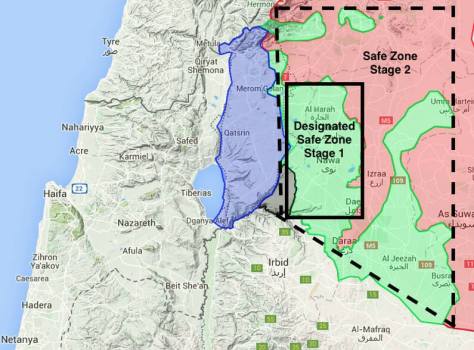
Civil organizations:
Many in the Syrian civil opposition organization have demanded the need to establish a safe zone, and carry this request by the National Syria Coalition and for the “Friends of Syria,” but this request was ignored as international organizations and those working in the field of relief were not yet committed to engage and seem to only be concerned with programs and humanitarian aid relief needed by local communities in southern Syria.
The only exception of the Amaliah organization is that it’s the only US organization which has announced it will spare no effort to convince the international and regional parties of the need to set up a safe zone in southern Syria.This plan depends on several stages beginning in the UN area of the Golan Heights and towards Syria, so that the restoration of schools and infrastructure, along with the provision of essential services for citizens will happen gradually. Amaliah wishes to expand the area until it will be able to contain and manage refugees from the camps that do not health and humanitarian conditions into account. Amaliah also strives to provide financial, social and psychological
support to the citizens.
:Article in Arabic
القنيطرة منطقة أمنة
:Sources
1- القنيطرة وفق موسوعة ويكبيديا: (alqueneitra Wikipedia
2- قرى محافظة القنيطرة: (alqueneitra towns Wikipedia)
3- جبهة انصار الاسلام: (gabat ansar alsham)
https://www.youtube.com/watch?v=6H_SniRyl8I
4- (gabat suar syria)
https://www.youtube.com/watch?v=7-JUsx4o5zU
https://www.youtube.com/watch?v=wymofMPrnB0
5- (aluyat alfurqan)
https://www.youtube.com/watch?v=OkQG7tNlO-Q
https://www.youtube.com/watch?v=JBcps4c3yNk
https://www.youtube.com/watch?v=g4fNc4HZAsk
6- (lyua alaz)
https://www.youtube.com/watch?v=9FXP4CuBgBc
https://www.youtube.com/watch?v=c7y6V-kjrNI
7- (Muhammad sarur zein alabadin wikipedia)
https://ar.wikipedia.org/wiki/%D9%85%D8%AD%D9%85%D8%AF_%D8%B3%D8%B1%D9%88%D8%B1
8- خالد زين العابدين: احد قيادي التيار الوطني السوري، وشغل منصب رئيس رابطة حوران عام 2015-2016. (Khaled zein alabadin wikipedia)
https://www.youtube.com/watch?v=PZr8s-XsAwE
9-: (local queneitra council)
10- (education in daraa and queneitra province)
11- (telephone interview with more than 13 people from south Syria from different political various)
12- for more information about
Translation By: Nadav Nusbam, Adam November

